This one was a request by one my readers and what a great suggestion! Taking this sensor apart proved a little bit of a challenge. It wasn’t as eager to give ups secrets as readily as some of the other ones I’ve opened up in the past. I also didn’t have a replacement cap for this, so I had to be careful.
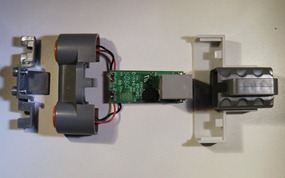 |
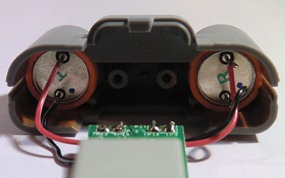 |
The plastic frame to the left actually sits inside the main part with the “eyes” and looks like it would be for holding in the receiver and transmitter but it’s not. I have no idea why this thing is in there. Edit: It has small tabs on it that click into the piece on the right. |
You can see the two transducers, one’s a receiver and the other’s the transmitter. Can you guess which is which? They’re super stuck in there. I tried to pry them out to no avail. The two little holes in the middle are for holding the screws for the small plastic frame on the image on the left. |
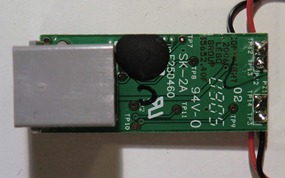 |
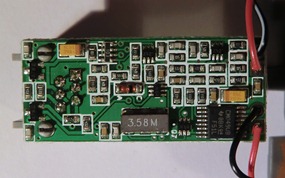 |
| The top side of the PCB. The connector is on the left and there seems to be a cloaked processor or other device under that blob. I am guessing it’s alien technology and the government (and LEGO) don’t want us to know. |
The reverse side of the PCB. You can see the wires going to the transducers and what appears to be a crystal and another processor. They really stuffed this side with components. |
So now you know what the LEGO Ultrasonic Sensor looks like on the inside. If there’s another sensor you’d like me to take apart so you can see what’s inside, let me know and I’ll see what I can do.
 Bot Bench I'd Rather Be Building Robots
Bot Bench I'd Rather Be Building Robots







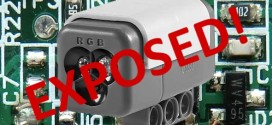
I don’t know if someone already opened up ‘the brick’ itself?!?
Sure, they have: http://thenxtstep.blogspot.com/2006/07/inside-nxt-brick-lots-of.html 🙂
The plastic frame on the first picture may limit crosstalk between TX and RX, so that the signal emitted is not directly received by the receiver.
Very fascinating, thanks for sharing those with us!
Wow that looks cool!
have u opend it cuse i sad i would like to see it or just cuse u had olraedy plant to do dat? (sorry for my bad english ik come from holland)
Yeah, you made the suggestion and that got me very curious! So yes, this post is a direct result of your question 🙂
wow realy much thanks!!!
and when u open it up dus it than stll works?
Yeah, it works fine.
trouwens jou achternaam is soldaat ben jij ook een nederlander?
When u now think huh wat is standing there ^^ . I asked u or u live in holland to cuse your last name is soldaat and i think thats dutch.
I am Dutch, yes 🙂 Ik spreek ook gewoon Nederlands.
okej dat is mooi. Ik wist niet dar veel goede mindstorms bouwers in nederland woonden 🙂
Meer dan je denkt!
kom je (mag ik je zeggen) ook naar legoworld?
Ik ben ook heel beniuwd hoe de NXT Compatible Linear Actuator van mindsensors er van binnen uit zou zien.
I’m not going to open up the Firgelli LA, I’m worried I won’t be able to put it together again and it’s impossible for me to get a replacement. So I’m afraid not.
ja dat klinkt logies
Ik zal op de Mindstorms/Technic stand zijn 🙂
Oké elke dag?
Nope, 19-23 October 🙂
oké ik kom 19 october
is de mindstorms stand weer zo groot als vorig jaar?
We hebben nu zelfs een aparte zaal, samen met Technic!
wow ik ben blij dat ik optijd kaarten heb gekocht 🙂
ik ben ook benieuwd hoe de hitechnic gyro sensor er van binnen uit ziet
I’m also curious how hitechnic gyro sensor on the inside looks like
(ik ben wel benieuwd naar veel dingen zeg)
Has sombady already opend up a nxt cable?
Sure, lots of people have. You can see what it looks like here: http://botbench.com/blog/2011/03/20/vex-cortex-i2c-nxt-cable-howto/
wow that looks cool
Has anyone ever openned up a nxt touch sensor? I’ve seen a rcx one opened up, but never a nxt one.
I am not sure, I will do some research. If they haven’t, I will take one of mine apart and put it on the website.
Philo has a couple pictures here: http://www.brickshelf.com/cgi-bin/gallery.cgi?f=445412
Hi Xander,
I guess you didn’t find the “I2C Address Selection Links” for me?
After taking a close look at the ‘Schematic’, has anyone played with the P1.0 to P1.3 configuration. It’s very interesting, as it looks like it may be the I2C Address ports?
We need some reverse engineering!
[…] has a nice post showing the internals of the sensor. Like this:LikeBe the first to like this. Tags NXT, US […]
PLEASE DO THE SOUND SENSER
Sounds like a good plan! I’ve never done that 🙂
Any sign of a way of changing the Sensors I2C Address?
I HAVE ONE NXT KIT; IN WHICH ULTRASONIC SENSOR IS NOT WORKING; WILL LEGO WILL REPLACE OR SERVICE THAT; OR CAN I GET THE INFO ABOUT THE SERVICING OF SENSOR AT OUR END;
HOW TO OPEN THE SENSOR?
For one, you should rip the caps lock off your keyboard, using it is like shouting, and considered rude. In any case, you should contact the LEGO helpdesk, they can help you with that. You should not try to “fix” it yourself. Have a look here http://service.lego.com/en-us/ and see how you can contact them in your country. LEGO are usually pretty good about replacing broken parts.
Will you be dissecting the EV3’s sonar any time soon? I would like to compare the new hardware.
Only if I have a spare one, which I don’t at the moment.
anyone know where I can get the datasheet of the transducers? or have information on how they work?
I don’t have this information but you should check out the HDK for more info on this. You can download that here: http://goo.gl/PsgvSR
I think that (looking from the front) the left transducer is the transmitter and the right one is the receiver, since (somehow!!) I can hear the ultrasound pings.
Are you sure it’s not tinnitus? 🙂
We measured it with an oscsilloscope.
Ultrasonic is sending in every 22ms 11 impulses with frequency 40kHz.
Which is which? This was so easy 🙂
T – Transmitter
R – Receiver
Simple as that! Believe me. We also measured it with an oscsilloscope.
http://www.robootika.com/post/Hakime-Ultrasonic-andurit.aspx
Thanks for sharing that article!